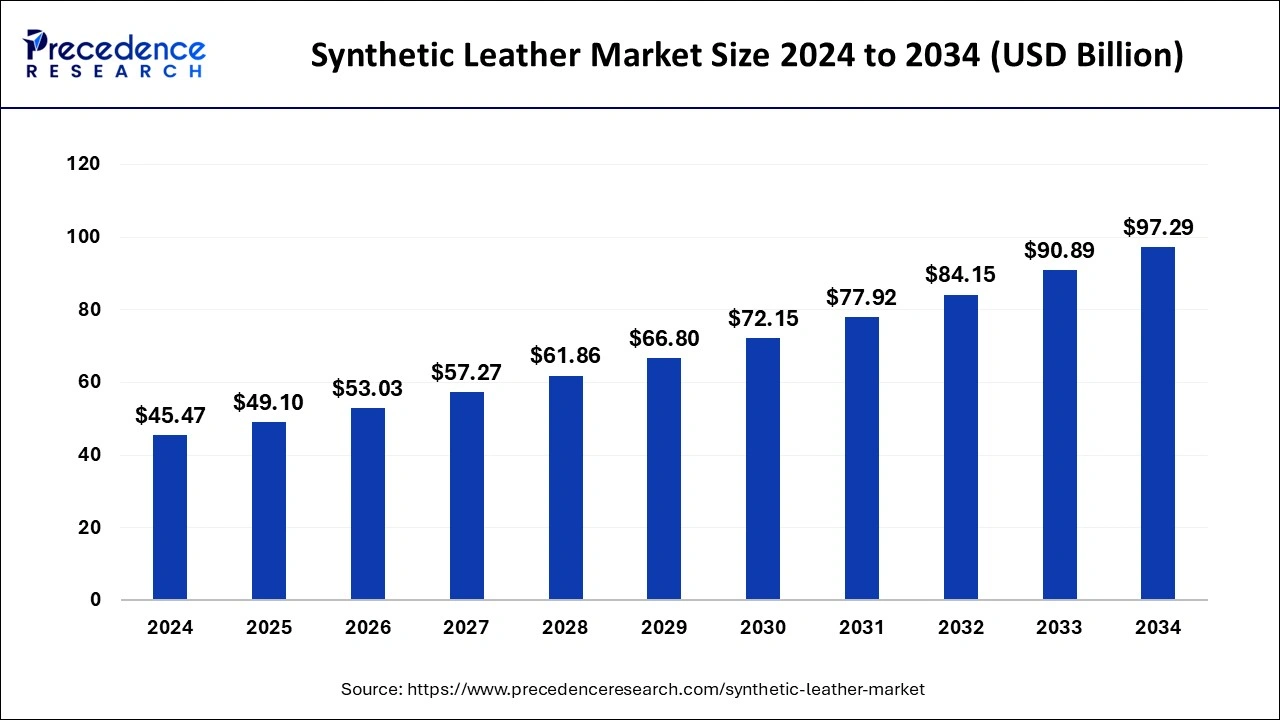Synthetic Leather Market Size to Surge USD 97.29 Bn by 2034
Synthetic Leather Market Size to Surge USD 97.29 Bn by 2034
The global synthetic leather market size was evaluated at USD 45.47 billion in 2024 and is estimated to surge around USD 97.29 billion by 2034 at a CAGR of 7.9%.

Get Sample Copy of Report@ https://www.precedenceresearch.com/sample/1144
The Impact of AI on the Synthetic Leather Market
Artificial Intelligence (AI) is transforming the synthetic leather industry in several ways:
- Material Innovation: AI algorithms assist in designing advanced synthetic leather with improved durability, texture, and sustainability.
- Smart Manufacturing: AI optimizes production processes, reducing material waste and enhancing energy efficiency.
- Quality Control: AI-driven inspection systems detect defects in synthetic leather, ensuring high-quality products.
- Personalized Consumer Experience: AI enables customization in synthetic leather-based fashion and interior products, aligning with consumer preferences.
- Supply Chain Optimization: AI and machine learning predict demand patterns, streamline logistics, and improve inventory management.
As AI continues to evolve, its integration into synthetic leather production is expected to enhance efficiency, cost-effectiveness, and sustainability.
Also Read: https://www.newsgazzete.com/advanced-ceramics-market/
Growth Factors Driving the Synthetic Leather Market
Several key factors are propelling the growth of the synthetic leather market:
- Rising Demand for Sustainable and Vegan Alternatives: Consumers and industries are shifting towards eco-friendly and cruelty-free leather substitutes.
- Advancements in Material Technology: Innovations in bio-based polyurethane (PU) and microfiber leather offer superior texture and durability.
- Expanding Automotive and Fashion Industries: The use of synthetic leather in car interiors, footwear, and apparel is increasing rapidly.
- Cost-Effectiveness Compared to Genuine Leather: Synthetic leather is more affordable than animal-based leather, making it attractive to manufacturers.
- Government Regulations and Ethical Concerns: Stringent regulations on animal-based leather production are driving the demand for synthetic alternatives.
Market Challenges
Despite its growth potential, the synthetic leather market faces several challenges:
- Environmental Concerns Related to PU and PVC Leather: Traditional synthetic leather made from polyurethane (PU) and polyvinyl chloride (PVC) poses environmental issues, such as plastic waste and toxic emissions.
- Durability Compared to Genuine Leather: While synthetic leather has improved, it still lacks the long-lasting durability of genuine leather.
- High Competition from Alternative Materials: Innovations in plant-based and lab-grown leather present challenges to synthetic leather manufacturers.
- Strict Environmental Regulations: Governments are imposing stricter regulations on synthetic leather production due to chemical waste and pollution concerns.
Regional Outlook
1. Asia-Pacific – The Market Leader
- In 2024, the Asia-Pacific region accounted for over 43% of the global synthetic leather market revenue.
- Countries like China, India, and South Korea are key manufacturing hubs, driven by high production capacity and cost-effective labor.
- The rapidly expanding automotive and fashion industries in this region are fueling the demand for synthetic leather.
2. North America – Steady Growth
- The North American market is expected to grow at a CAGR of 7.0% over the forecast period.
- The rising demand for vegan leather products and sustainable materials is a major driver.
- Increasing adoption in luxury automotive interiors and high-end furniture is propelling market expansion.
3. Europe – Sustainability Focus
- Europe is witnessing a shift towards bio-based and eco-friendly synthetic leather.
- Strict regulations on PVC-based leather are leading to growth in PU-based and plant-derived synthetic leather.
- Germany, France, and the UK are leading in innovation and sustainable fashion.
4. Latin America & Middle East – Emerging Markets
- These regions are experiencing gradual market expansion, driven by the growth of automotive and footwear industries.
- Brazil and Mexico are key players in synthetic leather production and exports.
- The Middle East is seeing increased demand for luxury automotive and furniture applications.
Latest Developments in the Synthetic Leather Market
1. Innovative Bio-Based Leather Alternatives
- Companies are developing biodegradable and plant-based synthetic leather using materials like pineapple leaves, mushrooms, and apple peels.
- Tesla and other luxury car brands are incorporating vegan leather interiors as premium options.
2. Strategic Partnerships & Expansions
- Leading manufacturers like Teijin Limited and Kuraray Co. Ltd. are expanding production facilities in Asia and North America.
- Brands like Nike and Adidas are launching sustainable synthetic leather shoes as part of their eco-friendly initiatives.
3. AI-Driven Manufacturing & Smart Textiles
- AI is being used to create synthetic leather with advanced textures and self-healing properties.
- 3D printing technology is being integrated into the production process to reduce material waste.
4. Increasing Regulations on PVC-Based Synthetic Leather
- Governments are imposing stricter regulations on PVC leather due to toxic chemical emissions.
- The shift toward water-based and solvent-free synthetic leather is gaining traction.
Ready for more? Dive into the full experience on our website@ https://www.precedenceresearch.com/
